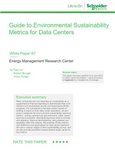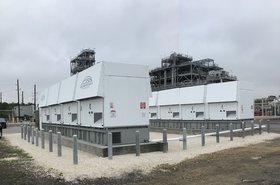This is Part One of a two-part series on hydrogen fuel cells in data centers. Read Part Two here
As data center operators continually look for ways to decarbonize their business operations, hydrogen has become a highly anticipated solution for storing and releasing low or zero-carbon energy.
When considering options for onsite electrical generators, there are very few practical options that can fit in a data center campus and produce no carbon emissions. When excluding renewables from our options, it leaves us with gas generators and fuel cells. Of the two remaining options, fuel cells have higher efficiency.
The cost-effectiveness depends on how they are used, whether it is for backup or continuous power. In terms of cost, hydrogen at present is prohibitively expensive, not to mention the infrastructure required to store it, and the significant storage difficulties due to its low density. While the cost of hydrogen is predicted to reduce over the next decade, making it more accessible, the issues around large-scale storage may prevent usage on many data center sites. In the future, there will be locations with gas pipelines that could provide hydrogen, but this may not be an economical option when compared to consuming electricity from the utility grid.
As hydrogen can react with oxygen to release energy with no carbon emissions, it is no surprise that current predictions demonstrate that by 2030, the hydrogen economy could be worth $500 billion. Hydrogen fuel cells combine hydrogen and oxygen to generate low or zero-carbon electricity which can be used to power a data center.
The majority of fuel cells currently in use in data centers are solid oxide fuel cells (SOFCs), providing constant power. SOFCs can generate power through the conversion of fuels such as natural gas and biogas, into hydrogen, which is then reacted in the fuel cell to generate power. While using natural gas still results in carbon emissions, SOFCs are able to generate power with higher efficiency than combustion engines. SOFCs can also be fuelled directly with hydrogen, although this is not the norm due to hydrogen’s cost and availability.
While it is capable of providing constant power, hydrogen fuel cells are also being considered for providing backup power to data centers. This is greatly appealing to data center operators as a more environment-friendly replacement for traditional diesel generators. This change would see the use of fast-start fuel cells, such as proton exchange membrane (PEM) fuel cells which could take the place of diesel generators.
SOFCs and PEM fuel cells differ from one another in their construction, materials, and operation. In a high-level view, the primary differences are the electrolyte materials (where the hydrogen and oxygen react) and operating temperatures. SOFCs operate at high temperatures, requiring longer start-up times and as a result, only being suitable for continuous power supply. PEMs, by contrast, operate at lower temperatures and are capable of fast-start or continuous operation, but are a more expensive option.
How exactly fuel cells will be used in future data centers is still up for debate, with operators considering both backup and constant power options. There are significant trade-offs with each option; using fuel cells for backup power requires large quantities of hydrogen to be stored onsite, which is costly, space-consuming, and high-risk, particularly when compared to current onsite diesel storage. Constant power usage, on the other hand, would see the fuel cells connected to a future hydrogen gas pipeline. The major disadvantage with this option is operating costs – as current data center operators state that they intend to use zero-carbon “green hydrogen,” using renewable electricity to split water via electrolysis. This is almost guaranteed to be more expensive than just using utility electricity directly due to electrolyzer efficiencies and losses in hydrogen distribution and storage.
Sustainability – a key driver in the use of hydrogen fuel cells
The key benefit and primary motivation for installing hydrogen fuel cells within a data center is to reduce carbon emissions. As stated, some fuel cells, such as SOFCs, can use natural gas. While it is less damaging to the environment than diesel, it still results in significant carbon emissions. This may be attractive for data center operators due to the cost of natural gas for industrial consumers versus the cost of utility electricity. Given the high efficiency of fuel cells, this allows data center operators to produce lower-cost electricity on site, with the downside of carbon emissions when using natural gas and added energy system complexity.
Fuel cells powered directly with hydrogen rather than natural gas have the opportunity to be sustainable, provided that the hydrogen does not originate from fossil fuels. Depending on its source, hydrogen has commonly referred to ‘color’ classifications to help differentiate how it has been produced and therefore how sustainable it is; hydrogen produced directly from natural gas is referred to as ‘grey,’ while hydrogen produced from natural gas with a carbon capture, utilization, and storage system (CCUS) is referred to as ‘blue.’ ‘Green’ hydrogen, produced via electrolysis with renewable energy, is often hailed as the gold standard. Additionally, there is ‘pink’ hydrogen - it is also produced via electrolysis like ‘green’ hydrogen however, it uses nuclear energy rather than renewable energy.
The goal to meet net zero-carbon targets, combined with the ongoing energy crisis, has also created a renewed interest in nuclear power which can provide vast quantities of low-carbon electricity. In addition to the low-carbon electricity source which can be used for electrolysis, there are proposals to utilize waste heat from high-temperature nuclear reactors, significantly reducing the energy required for electrolysis. This potentially results in more efficient and economical hydrogen production.
However, companies are increasingly facing pressure from investors to comply with Environmental, Social, and Governance (ESG) standards which is another reason why hydrogen fuel cells are appealing to data centre operators. This pressure is already pushing companies, including data center operators, to explore alternative technologies such as fuel cells, which may attract more investment and improve public image.
Implementing hydrogen fuel cells into the operational blueprint of a data center not only demands a holistic understanding of the current technological landscape but also a perspective that aligns with advancements, market dynamics, and evolving regulatory frameworks. Ultimately, the integration of hydrogen fuel cells into data centers should be navigated with a pragmatic strategy that intertwines sustainability aspirations with operational and economic viability, ensuring resilience, compliance, and competitiveness in an increasingly eco-conscious and regulated business environment.
Don't miss Part Two of this article series - the practicalities of hydrogen data centers





